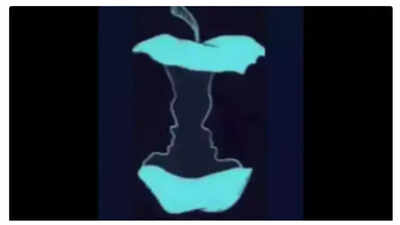Optical illusions are not just a source of entertainment; they also provide a fascinating glimpse into how our brains work. These visual puzzles challenge our perception and can reveal surprising insights about our thinking patterns and emotional intelligence. A recent optical illusion shared by Marina Winberg has taken social media by storm, prompting users to explore the depths of their personalities.

Optical illusions occur because the brain sometimes misinterprets the information received from our eyes. This can lead us to see things that aren't really there or perceive objects in ways that differ from reality. They arise when there's a conflict between the data our eyes send and the brain's interpretation.
The image in question presents viewers with two possible interpretations: an eaten apple core or two faces gazing at each other. According to Winberg, your initial perception can reveal key aspects of your character.
Take a moment to study the image carefully. What do you see first?
Those who immediately recognize the two faces tend to be logical and analytical thinkers. You likely possess a strong moral compass and prefer to think before acting. Stability is important to you, and you approach problems with a creative mindset. However, your curiosity can sometimes lead you down unexpected paths.
If the apple core is what stands out to you, you are likely an intuitive and emotionally aware individual. You have a knack for reading subtle cues and understanding unspoken emotions. While you often know the right thing to say, you may choose to remain silent. You value stability and are fiercely protective of the things that matter most to you.
Optical illusions are categorized into three main types:
Literal Illusions: These illusions occur when the brain pieces together different elements of an image to create a perception that doesn't exist in reality. The "two faces or a vase" illusion is a classic example of this.
Physiological Illusions: These illusions arise from overstimulation of the visual system. Exposure to excessive light, movement, or color can lead to effects such as afterimages or motion illusions.
Cognitive Illusions: These illusions are based on the brain's subconscious interpretation of information. The Müller-Lyer illusion, where lines appear to be different lengths due to surrounding shapes, falls into this category.
Newer articles
Older articles
 Emma Raducanu Shuts Down Carlos Alcaraz Dating Rumors, Confirms US Open Mixed Doubles Partnership
Emma Raducanu Shuts Down Carlos Alcaraz Dating Rumors, Confirms US Open Mixed Doubles Partnership
 Woakes Regrets Umpiring Decisions as India Seize Control on Day 1 at Edgbaston
Woakes Regrets Umpiring Decisions as India Seize Control on Day 1 at Edgbaston
 Black Caps Primed for Blockbuster Home Summer Against Cricket Giants
Black Caps Primed for Blockbuster Home Summer Against Cricket Giants
 Gambhir Defends India's Tailenders After Test Collapse, Cites Missed Catches as Key Factor
Gambhir Defends India's Tailenders After Test Collapse, Cites Missed Catches as Key Factor
 SA20 Teams Given Green Light for Six Player Retentions Ahead of Auction
SA20 Teams Given Green Light for Six Player Retentions Ahead of Auction
 Rishabh Pant: Revolutionizing Cricket with Unconventional Batting, Says Greg Chappell
OR
Greg Chappell Hails Rishabh Pant as Cricket's "Reinventor"
Rishabh Pant: Revolutionizing Cricket with Unconventional Batting, Says Greg Chappell
OR
Greg Chappell Hails Rishabh Pant as Cricket's "Reinventor"
 Mirabai Chanu: Olympic Medalist's Relentless Training Regimen Extends Even to Family Time
Mirabai Chanu: Olympic Medalist's Relentless Training Regimen Extends Even to Family Time
 Rishabh Pant's "Game-Changing" Centuries vs. England Earn Praise From Greg Chappell
Rishabh Pant's "Game-Changing" Centuries vs. England Earn Praise From Greg Chappell
 Small Steps, Big Heart: Science Reveals Simple Habits for Optimal Cardiovascular Health
Small Steps, Big Heart: Science Reveals Simple Habits for Optimal Cardiovascular Health
 Kavya Maran, SRH CEO, Addresses Viral Meme Status and Passion for Cricket Team
Kavya Maran, SRH CEO, Addresses Viral Meme Status and Passion for Cricket Team